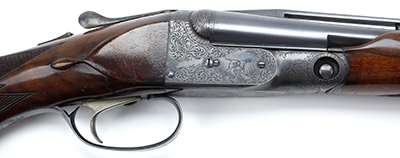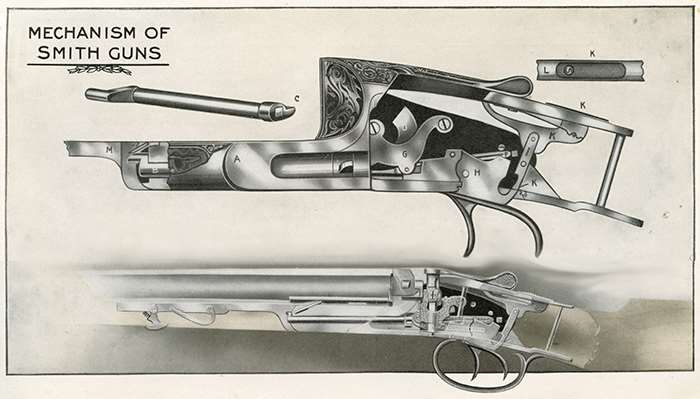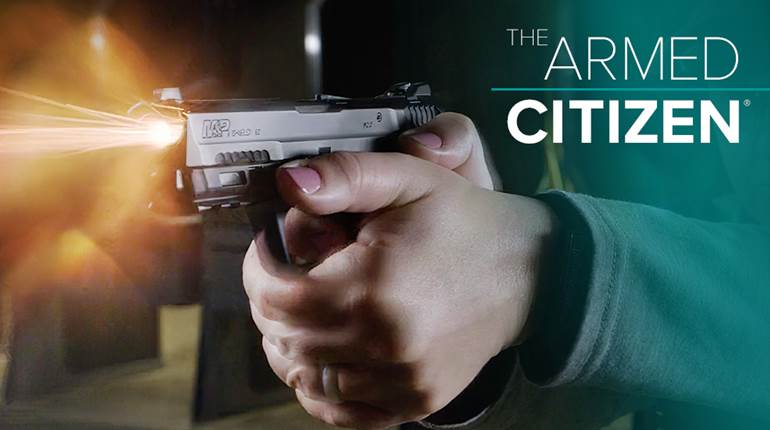
By all accounts, the sidelock double-barreled shotgun belongs to the British. Indeed, “best guns,” from makers such as Purdey and Holland & Holland set the tone for the classic gentleman’s sidelock of the 19th and 20th centuries. Although in America, names such as Parker and Remington were giving the Union Jack a run for its money, the hammerless versions produced by these firms were boxlocks, which became the norm.
Only one firearm manufacturer emerged with the mechanical skills to produce an American hammerless sidelock—an elegant, sturdy shotgun that took the name of its creator—L.C. Smith, or “Sweet Elsie,” as this well-designed side-by-side was affectionately called.
Lyman Cornelius Smith had been in partnership with his brother, Leroy, and a neighbor, W.H. Baker, manufacturing and marketing Baker’s unique three-barreled drilling, which consisted of side-by-side 12- or 10-ga. smoothbores over a .44-40 Win. barrel. But this European-style design was not popular in America, and by 1880, L.C. Smith found himself the sole proprietor of W.H. Baker & Co.
Having married into a prosperous family, money was not a problem for Smith—but success was. Sales were lagging. Fortunately, the entrepreneurial Smith had an inventive employee named Alexander T. Brown (who went on to develop the Dunlop tire and other automotive inventions in later years). Brown designed an exposed-hammer sidelock double, which involved a sturdy “double cross-locking” rotary bolt, a strengthened barrel hinge and hammer ears that dropped below the shooter’s line of sight when cocked. Produced in 10 and 12 gauge, the new “L.C. Smith Hammer Gun” was introduced in 1884 with much fanfare and success.

This greatly improved smoothbore was offered in a number of grades, or “qualities,” as the company initially called them—ranging from 2 through 7 (or A to F and AA in subsequent catalogs) and priced from $55 up to $450—princely sums in the days of a $16-a-week average paycheck. For escalating qualities and prices, customers could have progressively better grades of Damascus, and later, fluid steel barrels, more engraving, and better, more finely checkered wood. In 1913 the L.C. Smith grading system changed to reflect names such as Field, Ideal, Olympic, Trap, Specialty, Eagle, Crown, Monogram, Premier and De Luxe. In addition, a 12-ga., single-barreled trap gun was produced between 1917 and World War II.

Clearly the L.C. Smith shotgun was geared toward sportsmen who wanted the best and were willing to pay for it. But while the shotgun attracted well-heeled hunters, it failed to hold L.C. Smith’s attention; he had become enthralled with developing a new-fangled device called the typewriter. Thus, in 1888, Smith sold his company to a Fulton, N.Y., railroad builder named John Hunter, Sr. Hunter was looking for new ventures and was planning to invest in a shotgun that a neighbor named Harry Comstock was developing. Indeed, had Smith not learned about Hunter’s gunmaking interests, you might now be reading about the Comstock shotgun instead of the L.C. Smith. But alas for poor Harry, his patents and a pending partnership were scrapped once Hunter met Smith. After all, here was an already-established, quality shotgun, with machinery and workers in place. Consequently, L.C. Smith went on to create what would become the famous Smith-Corona typewriter, and Hunter Arms Co. was established to manufacture the equally famous L.C. Smith shotgun.
It was under the Hunter Arms banner, which flew from 1889 until 1945, that the L.C. Smith legacy was established. After all, this was America’s "Golden Age of Shotgunning," and now we had our very own sidelock with which to break records and bag birds. In 1889, the Hunter Arms Co. built a factory in Fulton, N.Y., a location that—under the leadership of John Hunter, Sr., and, over the years, with his six sons—was to become revered in the annals of shotgunning.
The guns were stamped “L.C. Smith” on the lockplates, while the barrels were marked, “HUNTER ARMS CO.–MAKERS–FULTON, N.Y.” In 1891, a 16 gauge was added to the line, and in 1896 a few 8 gauges were produced; however, they were discontinued one year later and are extremely rare. In 1908, the first L.C. Smith 20 gauge made its appearance. Only one 28 gauge was made, serial No. 100, and the .410 bore was introduced in 1926, with a scant 2,665 of these smallbore shotguns known to exist.
In 1892, L.C. Smith became the first U.S.-made shotgun to feature automatic ejectors, specially featured, in 1895, on its top-of-the-line A3 Automatic Ejector gun. Additionally, in 1904, the company catalog touted its new Hunter One-Trigger, a non-selective system that fired the right barrel first. The Hunter One-Trigger could be ordered in any of three fixed positions, forward, middle of the trigger guard or to the rear. It was extremely fast, yet was guaranteed against doubling. Later, in 1935, a selective, single trigger was offered.

Every L.C. Smith exuded quality, from the “workhorse” blued and casehardened 00 Field Grade to the elaborately engraved and checkered A3 Monogram. Internally, all guns exhibited the same excellent workmanship. Barrels were imported rough-bored, then reamed and polished at the factory. Initially there were varying grades of Damascus, ranging from English Stub Twist to the finest qualities and patterns. Later, only the best steel tubes were used, escalating in quality from Armour Steel on the Field Grade to Nitro and Royal Steel on the higher grades. Each tube was hand-straightened, and the pairs of tubes were brazed together, rather than soldered. All internal parts were mirror-polished and hand-fitted. Higher grades had internal parts damascened, like a fine pocket watch. Stocks were American, English or French walnut, shaped at the factory and hand-rubbed with linseed oil—the higher the grade, the more coats the stock received. The completed guns were then test fired for patterning perfection at the company’s indoor range.
Unfortunately, reoccurring gremlins of financial woes and mismanagement plagued this family-owned operation, and in 1917 the Hunter Arms Co. filed for bankruptcy. But the reins were quickly picked up by a small cadre of Fulton businessmen who didn’t want to lose L.C. Smith, which was the town’s claim to fame. Nonetheless, in 1920 the company was sold to the Simmons family of Massachusetts, who unfortunately, also did a less-than-stellar job of management. On one occasion, Hunter Arms was contracted to make a bolt-action shotgun for Sears, Roebuck & Co., but a miscalculation of costs resulted in financial catastrophe. In 1939, the company was put up for sale, but World War II halted negotiations. After continuing shotgun making for both civilian and government customers, Hunter Arms again went into bankruptcy.
But to its rescue rode the Marlin Firearms Co., which, on Nov. 20, 1945, purchased the assets. The plant was reopened as the L.C. Smith Gun Co.—the first time “Smith” was included as part of the company name. It was a perfect match as Marlin, led by Frank Kenna, was also family-owned. Unfortunately, after only five years, in which a total of 57,929 guns were made, a floor in the factory collapsed, putting L.C. Smith out of business.
In 1967, Frank Kenna, Jr., the new president of Marlin, resurrected L.C. Smith as a limited-production gun. This time it was made in Marlin’s New Haven, Conn., factory. Only offered in 12 gauge, it differed from the original in that it featured a ventilated rib. But the demands of producing a labor-intensive sidelock, plus competition from imports, and the popularity of pumps and semi-automatics doomed the “Elsie.” A scant 2,539 Marlin-made L.C. Smiths were all that remained of this classic double before production was finally halted in 1971.
Interestingly, Marlin resurrected the L.C. Smith once again, but this time it was in name only. The resulting side-by-side was in reality a boxlock made in Italy, and featured false sideplates to make it look like a sidelock. It was offered in 12 and 20 gauges, and there was an Italian-made L.C. Smith over-and-under as well. Both had false sideplates and were made for Marlin by the well-known firm of Fausti Stefano. They were cataloged from 2005 through 2009.
It is interesting to note that L.C. Smith, the man who gave his name to this legendary American sidelock, was involved in their manufacture only for a brief four-year period. Yet his namesake shotgun continues to endure as both a highly desirable hunting companion and as a collectible, while the typewriter he also invented has long become obsolete.





































